Abstract
This study examines the effect of two self-developed novel fireproof coatings on the fire resistance of carbon fiber-reinforced polymer (CFRP) composite sheets. The post-fire flexural properties were chosen as important indicators of fire resistance. This research involves two distinct fire conditions, the standard fire condition and the large-space fire condition, to simulate general interior fires and large-space fires. The post-fire flexural performance of CFRP sheets coated with two different self-developed fireproof coatings was evaluated through three-point bending tests after fire exposure. The experimental findings demonstrated a significant reduction of up to 80% in the post-fire flexural properties of CFRP sheets without fireproof coatings. However, CFRP sheets coated with fireproof coatings exhibited a substantial enhancement in their post-fire flexural properties. Under the large-space fire condition, the fire-resistance duration of CFRP sheets coated with fireproof coatings of at least 25 mm thickness exceeded 2 h, satisfying the requirements of GB50016-2014 fire-resistance class III (columns), class I (beams), and class I (floor slabs), respectively. Under the standard fire condition, CFRP sheets covered by fireproof coatings of 35 mm thickness exhibited a fire-resistance duration of 0.75 h, meeting the requirements of GB50016-2014 fire-resistance class IV (columns), class IV (beams), and class III (floor slabs), respectively.
1. Introduction
The growing demand for high-performance, reliable, cost-effective, and eco-friendly structural systems is driving increasing attention toward the utilization of novel materials in engineering practices. Among these materials, there is a notable emphasis on carbon fiber-reinforced polymer (CFRP) composites due to their exceptional performance [1,2,3]. CFRP composites are non-metallic materials composed of carbon fibers as the reinforcing material, synthetic resin as the matrix material, and the appropriate amount of auxiliary agents [4,5]. Naguib and Zhang [6] prepared “green” recycled polyester based on PET and oleic acid, which could be used to prepare CFRP composites, making it very environmentally friendly. CFRP composites exhibit higher strength-to-weight ratios and exceptional durability in comparison to conventional steel reinforcements. Their high malleability allows them to be fabricated into various shapes and sizes, including profiles, sheets, plates, and bars, making them suitable for diverse engineering applications [7]. Significantly, CFRP composites find applications in two primary civil engineering fields: as structural reinforcement elements for existing structures and as elements to partially or entirely replace conventional steel bars in newly built structures [8,9,10,11,12].
However, given the potential exposure of infrastructures to fire hazards, it becomes essential to address the concerns related to their performance under fire conditions when considering their implementation in structures. Notably, the first author, Qiang et al., undertook systematic investigations into the behavior and mechanical performance of high-strength steel S460, S690, and S960, both under fire conditions and after cooling down from fire [13,14,15]. These investigations utilized various methodologies, including controlled fire simulations and rigorous material testing procedures. The findings from these studies revealed significant degradation in material properties, including strength, modulus, and ductility. The methodology and findings of these studies provide key guidance for the design of the experiments in this paper, particularly with regard to fire simulation and the selection of experimental parameters. Based on the experience of these studies, it is possible to more accurately determine the material performance metrics that need to be evaluated.
Under fire conditions, CFRP composites are directly exposed to heat flow and flame as structural reinforcement elements. While they serve as internal bars, they are not directly exposed. Despite the concrete cover insulating CFRP elements from heat flow, the concrete cover may fall off when the temperature exceeds a certain threshold, exposing CFRP elements to fire [8]. Additionally, high temperatures could lead to a decrease in the bonding strength between FRP composites and concrete [16].
Carbon fibers can withstand elevated temperatures exceeding 2000 °C [17]. However, when subjected to elevated temperatures, CFRP composites could experience significant degradation in their mechanical properties due to the resin’s decomposition. This degradation becomes pronounced as the temperature surpasses the glass transition temperature (Tg), usually ranging between 50 °C and 120 °C [18,19]. During this phase, a transition to a rubbery state occurs in the resin, leading to fiber–resin debonding as well as a rapid decline in strength. Subsequent cooling from this temperature range permits partial recovery of the mechanical performance of CFRP composites [20,21]. It should be noted that surface temperatures in hot environments exposed to sunlight can also reach Tg. Once the temperature surpasses the decomposition temperature (Td), which generally falls between 300 and 400 °C, the resin matrix almost completely degrades, causing a substantial decrease in material properties. Furthermore, this process triggers the emission of smoke, soot, and harmful volatile substances into the surrounding environment. After exceeding the decomposition temperature, it is generally impossible to restore the original mechanical properties of CFRP composites through cooling [4,22,23,24,25,26].
Various studies have investigated the impact of high temperatures on CFRP materials. In the research conducted by Hamad et al. [5], an experiment was performed on the FRP bars to investigate the temperature impact on the elasticity modulus and strength. Their findings revealed that CFRP bars experienced a 47% decrease and a 71% reduction in elastic modulus and strength after being exposed to 375 °C. Yu and Kodur [25] explored the influence of temperature on the tensile mechanical properties of NSM CFRP rods and strips. Their results highlighted a significant decline in these properties beyond the threshold of 300 °C. Furthermore, Wang et al. [17] delved into the mechanical performance of pultruded carbon fiber-reinforced polymer plates under high-temperature conditions. Their outcomes revealed a pronounced decrease, reaching 50% of the strength at 300 °C and further diminishing to 7% at 700 °C. Ashrafi et al. [27] examined the impacts of high temperatures on both the physical and thermal performance of CFRP bars. Their study demonstrated substantial reductions of approximately 50–70% in the ultimate tensile strength of CFRP bars at an extreme temperature of 450 °C. Wang and Kodur [28] conducted comprehensive experimental research to investigate the strength and stiffness performance of CFRP composite bars at high temperatures. Their investigation indicated that the stiffness of CFRP bars at temperatures below 350 °C was about 90% of the initial stiffness, and the strength diminished to approximately 35% of its initial strength at around 350 °C.
To mitigate the adverse effects of fires on CFRP composites and ensure structural safety, it is essential to identify suitable fireproof solutions. Numerous research endeavors have explored various methods to reduce the influence of high temperatures on CFRP composites, including using flame-resistant materials, adding macro and nanoparticulate additives to the substrate, and applying ceramic heat barriers and fireproof coatings. Jarrah et al. [19] performed tensile tests on the CFRP sheets covered by intumescent fire retardant paint. Their findings indicated that the unpainted CFRP sheets experienced a 67% reduction in tensile strength, while the painted CFRP sheets exhibited a 60% reduction at 600 °C. Xu and Wang [29] examined the fire resistance of a variety of high-temperature-resistant CFRP tendons. Their findings showed that the strength endured at 78% when subjected to 200 °C, and the elastic modulus maintained a level of 82% at 300 °C. Khaneghahi et al. [30] showcased the effectiveness of intumescent paint in preventing the deterioration of the mechanical performance of CFRP bars within the temperature range of 350–600 °C. In addition, Shekarchi et al. [31] explored the influence of incorporating ammonium polyphosphate (APP) as a fire-retardant filler on the mechanical properties of CFRP composites. The experimental results revealed that, with increasing exposure temperatures, the strength degradation rate of composites containing APP filler was significantly lower than that of composites without this filler. Naguib [32] prepared a new environmental fire-retardant polymer nanocomposite using a recycled polyester matrix and Mg(OH)2 nanofiller. The findings revealed that the nanocomposite exhibited high fire retardancy performance. Furthermore, Rallini et al. [33] studied the thermal behavior of a carbon fiber composite infused with boron carbide nanoparticles. The experimental data suggested that the inclusion of boron carbide improved the thermal stability of the composite. Additionally, the ACI 440.2R-17 [34] specification recommends using fireproof coatings to improve the performance of FRP composites under high temperature conditions. However, the available fireproof coating for CFRP composites and related studies are very limited.
This study developed two novel types of fireproof coatings to minimize the performance degradation of CFRP composites under fire conditions. The self-developed fireproof coatings serve as a protective barrier, minimizing heat transfer to CFRP composites and preventing the resin from reaching critical temperatures during fire exposure. The objective of this study is to examine the effect of two self-developed fireproof coatings on the fire resistance of CFRP composite sheets. The assessment of fire resistance involves the retention of the mechanical and thermal properties and integrity of materials after fire exposure. Post-fire material properties are important indicators for evaluating the safety of the structure after fire exposure. Notably, it is important to mention that existing studies have mainly emphasized the tensile properties of CFRP composites, with relatively limited research on their flexural properties. However, in practical engineering applications, CFRP elements, especially the CFRP sheets for structural strengthening applications, may be subjected to both tensile and bending loads. Therefore, the post-fire flexural properties were chosen as an important indicator of fire resistance in this study. Three-point bending tests on CFRP sheets coated with fireproof coatings of three different thicknesses after being subjected to the standard fire and the large-space fire were conducted in this research to evaluate the post-fire flexural performance. The experimental results provide substantive references to the fire-resistance application and design of CFRP composites in infrastructure to ensure the fire safety of CFRP elements in newly built structures and CFRP sheets for structural reinforcement applications.
2. Experimental Program
2.1. Test Material and Specimen
The test materials used in this study were supplied by the manufacturer to ensure the quality and consistency of CFRP composites. The mechanical and thermal properties of CFRP composites are tabulated in Table 1. The test specimens were CFRP sheets with dimensions of 200 mm × 50 mm and thicknesses of 1.2 mm, 2 mm, and 3 mm, as depicted in Figure 1. There were eight specimens in each thickness group, for a total of 24 specimens.

Table 1.
The property of CFRP composites.
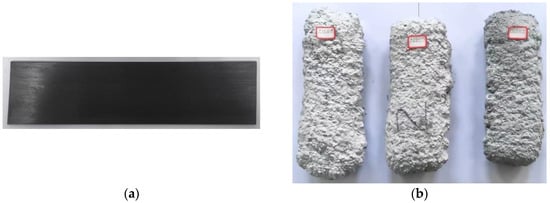
Figure 1.
Specimen preparation: (a) CFRP sheet; (b) CFRP sheets covered by fireproof coatings.
In the research, two types of self-developed gypsum-based thick fireproof coatings were applied to the surface of the CFRP sheets: non-intumescent fireproof coating 3119 (C1) and non-intumescent fireproof coating 5119 (C2). The two fireproof coatings are primarily composed of gypsum as the main base material, combined with a powder made of inorganic lightweight thermal insulation materials and fiber materials. Subsequently, the specimens underwent a cure process for a duration of 20 days to ensure that the coatings were fully set and their properties were stable. The cured coated CFRP sheets exhibited a white inorganic dense layer formed on their surface, as depicted in Figure 1. The states and parameters of each specimen were recorded for comparative analysis before the test.
2.2. Test Equipment
The bending tests were carried out utilizing the MTS E45.305 testing machine, which was an integrated digital closed-loop control mechanical testing system equipped with the LPS.305 load cell, as depicted in Figure 2. The MTS testing machine featured three types of closed-loop control for stress, strain, and displacement, with a maximum loading force capacity of 300 kN and a loading rate adjustment range of 0.001–254 mm/min. During the test, the lower actuator of the machine served as a fixed bearing point while the upper actuator moved to apply the load. The loading rate was adjustable to suit the specific test requirements. The fire conditions required for the tests were provided by the YFFK/10QK electric furnace, which has a maximum heating temperature of 1000 °C.

Figure 2.
MTS testing machine.
2.3. Specimen Conditions
The test was divided into three groups: (1) unconditioned as a reference, tested without fireproof coatings at ambient temperature; (2) conditioned, tested without fireproof coatings after fire exposure; and (3) conditioned, tested with fireproof coatings after fire exposure.
The ambient temperature was maintained at 23 ± 2 °C. This study considered two different fire conditions, including standard fire and large-space fire conditions, to simulate the air warming of general interior fires and large-volume space fires, respectively. Both of these fire conditions are essential fire models in engineering practice. The standard fire heating curve recommended in ISO 834-1:1999 [35] was employed. This is a representative fire temperature curve derived from actual fire data through statistical analysis and theoretical derivation, as depicted in Equation (1).
T = 345 lg(8t + 1) + 20
In the above equation, T is the temperature after t minutes of heating. In addition, the large-space fire condition represents a fire scenario that occurs in large building spaces, the model of which is recommended in CECS 200-2006 [36] and depicted in Equation (2). Flame spread and heat transfer processes under large-space fire conditions are relatively complex and influenced by multiple factors, such as object distribution and ventilation conditions.
T(x,z,t) = Tz(1 − 0.8e−βt − 0.2e−0.1βt) × [η + (1 − η)e−(x−b)/μ] + 20
In the above equation, T is the temperature after t seconds of heating. Tz is the air temperature at a vertical distance z (m) from the ground on the centerline of the fire source. b is the distance from the center of the fire shape to the outermost edge of the fire. β is a coefficient related to the power of the fire source and the fire growth type. η is the temperature attenuation coefficient at a horizontal distance of x (m) from the center of the fire source. μ is also a coefficient. The physical significance of the relevant parameters in Equation (2) is shown in Figure 3.
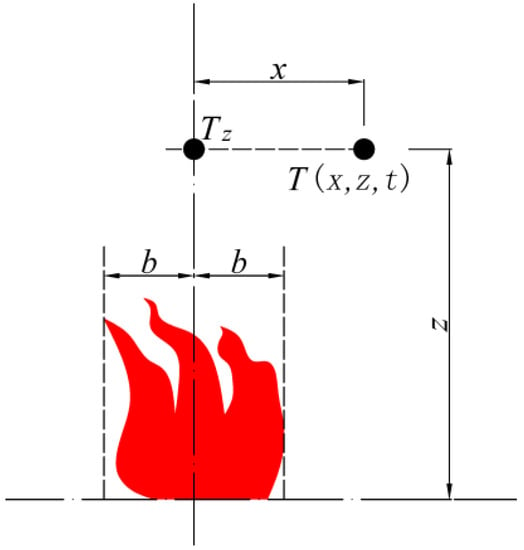
Figure 3.
Schematic representation of the parameters of the large-space fire.
For the uncoated group, the fire conditions were set as the large-space fire condition for a 2 h heating period, characterized by a floor area of 500 m2, a building height of 4 m, a medium speed fire growth type, and a medium power level of firepower. For the coated group, the fire conditions included exposure to standard and large-space fire conditions. The large-space fire conditions of the coated group were set up to be consistent with those of the uncoated group, while the continuous heating durations under standard fire conditions were 0.5 h, 0.75 h, and 1 h. The standard fire and large-space fire heating curves are illustrated in Figure 4.
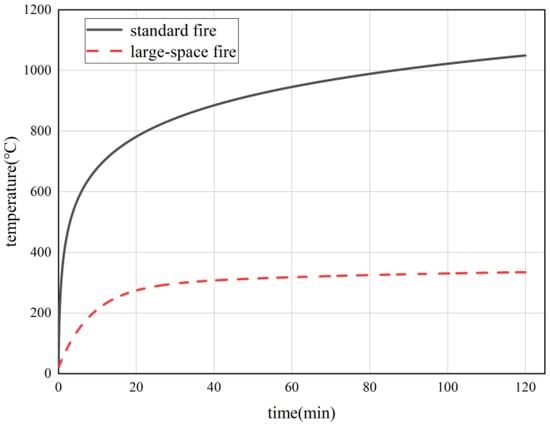
Figure 4.
The standard fire and large-space fire heating curves.
Based on specific structural design and fire protection specification GB14907-2018 [37], the coating thicknesses for the test CFRP specimens under the large-space fire condition were 15 mm, 25 mm, and 35 mm, corresponding to Type C1 and C2 coatings. The application of fireproof coatings with different thicknesses allows for the observation and comparison of differences in the fire resistance of CFRP sheets to evaluate the performance of the fireproof coatings. It provides references and recommendations for selecting the appropriate coating thickness for structural design and reinforcement. Under standard fire conditions, the coating thickness of the specimens was consistently maintained at 35 mm to investigate the ultimate fire-resistant duration that the CFRP sheets with the thickest coatings could withstand.
Beyond the decomposition temperature, the CFRP composites may burn. Consequently, based on the specification GB50016-2014 [38], the heating duration of the large-space fire condition is set at 2 h, while the temperature reaches 334.4 °C. For the standard fire condition, the temperature is 1049 °C after 2 h heating, exceeding the temperature range of the heating furnace. In order to determine the fire protection effect of the fireproof coatings under standard fire conditions, a more detailed range of different heating durations is chosen: 0.5 h, 0.75 h, and 1 h within the range of the heater furnace. The setup of the test is shown in Table 2.

Table 2.
The test setup in this research.
2.4. Test Procedure
The YFFK/10QK electric furnace was employed for the specimens to control heating. Each specimen was heated according to the fire conditions in Table 2. Upon reaching the designed heating duration, the specimens were subsequently cooled down to room temperature, and the surface coatings were removed from the CFRP sheets.
Prior to the bending test, a preloading step was conducted to verify the normal operating status of the testing machine and displacement sensors. The bending tests were performed on the specimens using the MTS testing machine at ambient temperature. The specimens were placed on the MTS testing machine with a span of 64 mm and a cantilever length of 68 mm outside the support points at both ends, not less than 1/10 of the support span, which satisfied the requirement of ASTM D790 [39]. The bending tests were carried out using the three-point bending method at a displacement control rate of 2 mm/min, as shown in Figure 5. All the bending experiments were conducted at ambient temperature until reaching failure.
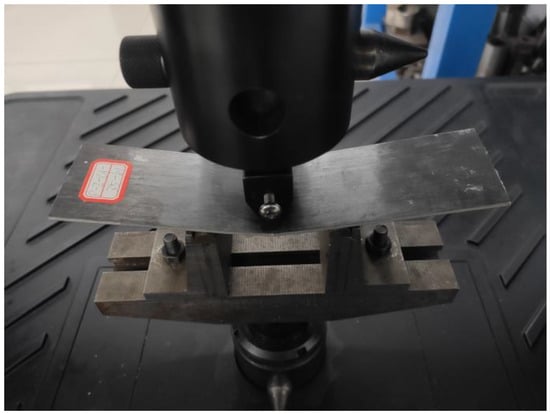
Figure 5.
Three-point bending test on the specimen.
3. Experimental Results and Discussion
The results of the three-point bending tests are presented and discussed as follows:
3.1. Large-Space Fire Condition
Figure 6 depicts the uncoated and coated CFRP sheets after exposure to the large-space fire (before and after the removal of coatings). After 2 h heating, the surface of uncoated CFRP sheets became rougher, and cracks emerged. This observation indicates that the resin matrix had started to degrade at a temperature of 334.4 °C, leading to the gradual separation of the fibers. Furthermore, the fireproof coatings on the coated CFRP sheets displayed an oxidation phenomenon, resulting in a darkening of color. The morphology of CFRP sheets after fireproof coating removal showed minimal variance from that of CFRP sheets at ambient temperature without fire exposure. Figure 7 presents typical failure modes of CFRP bending test specimens without fire exposure and after exposure to large-space fire. After cooling down from elevated temperatures, the failure modes of coated CFRP specimens did not exhibit substantial differences from those without fire exposure.

Figure 6.
CFRP sheets exposed after a 2 h large-space fire: (a) without fireproof coatings; (b) with fireproof coatings; and (c) after the removal of coatings.

Figure 7.
Failure modes of CFRP specimens: (a) at ambient temperature; (b) without coatings after exposure to the large-space fire; and (c) with coatings after exposure to the large-space fire.
In the three-point bending tests, both the loads and deflections of the specimens were recorded. Figure 8 displays load–deflection curves of CFRP specimens with different thicknesses after exposure to the large-space fire. Each curve in the plot corresponds to a specific CFRP specimen, where the x-axis and y-axis represent the deflection and load, respectively. These load–deflection curves clearly demonstrated linear-elastic characteristics, devoid of apparent inelastic alterations. As loading progressed, the curve gradually rose linearly. Eventually, upon reaching a load threshold, the specimen suddenly failed and underwent brittle damage. The peak loads of uncoated CFRP sheets experienced a significant reduction, while those of coated CFRP sheets exhibited no obvious decreasing trend. The fracture deflection remained almost unchanged under different coating conditions.
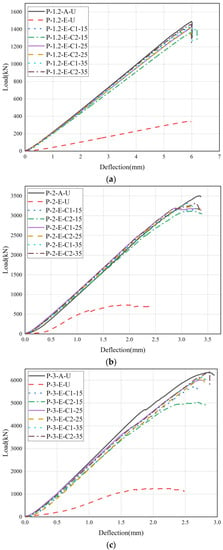
Figure 8.
Load–deflection curves of CFRP sheets with various thicknesses after large-space fire exposure: (a) 1.2 mm thickness; (b) 2 mm thickness; and (c) 3 mm thickness.
The flexural properties of CFRP specimens after exposure to the large-space fire are summarized in Table 3, which also includes the ambient-temperature group for comparison. The flexural stress is calculated using Equation (3).
σb = 3PL/2wh2

Table 3.
Bending test results of CFRP sheets at ambient temperature and after exposure to the large-space fire.
In the above equation, σb is the flexural stress. P is the loading force. L is the span. w and h are the width and thickness of specimens, respectively. In addition, the midpoint strain is calculated using Equation (4).
ε = 6Dmaxh/L2
In the above equation, ε is the midpoint strain. Dmax is the deflection at mid-span. h and L are consistent with Equation (3). The flexural modulus is calculated from the slope of the stress–strain curve. From the table, it can be seen that the flexural properties of CFRP specimens with different thicknesses at room temperature are different. Therefore, the reduction factor η is defined as the ratio of properties exhibited by CFRP sheets with different thicknesses under fire conditions to those with the corresponding thicknesses at ambient temperature to quantify the degree of property degradation.
The post-fire flexural strength of 1.2 mm, 2 mm, and 3 mm thick CFRP sheets without fireproof coatings under the large-space fire condition was reduced to 0.232, 0.211, and 0.197 times, respectively, compared to that at ambient temperature. This underscores a substantial decline in the flexural strength of CFRP composites, resulting in a significant decrease in the load-carrying capacity of CFPR sheets after exposure to a large-space fire. This can be attributed to the softening of the resin matrix at elevated temperatures, which leads to a decrease in the ability to transfer forces between the fibers and resin. Consequently, the wide application of CFRP composites in practical engineering necessitates fire protection.
Remarkably, the application of fireproof coatings significantly enhanced the post-fire flexural strength of the coated CFRP sheets, but the strength was still reduced to a certain extent compared to that at ambient temperature. The enhancement of fireproof coatings is primarily influenced by three factors: coating thickness, coating type, and CFRP sheet thickness. With coating thickness increasing, the reduction factor gradually escalated, implying that thicker coatings provided better fire protection by retarding the temperature rise of the CFRP sheets under fire conditions and preventing the fire from propagating to the interior of the CFRP sheets. The strength reduction factors stabilized around 0.95 when the coating thickness exceeded 25 mm. Further increases in coating thickness were unlikely to cause a significant alteration in the strength reduction factor. This may be related to the properties of coatings, such as thermal insulation and flame retardancy, which might reach saturation beyond a specific thickness. In addition, when subjected to fireproof coatings of 15 mm thickness, CFRP specimens with Type C1 coating exhibited superior performance compared to those with Type C2 coating. However, this performance difference became less prominent with thicker fireproof coatings (25 mm and 35 mm). Moreover, for fireproof coatings of 15 mm thickness, the strength reduction factors for CFRP sheets of 1.2 mm thickness were higher than those for CFRP sheets of 2 mm and 3 mm thickness. Nonetheless, this phenomenon seemed to be insignificant when thicker fireproof coatings (25 mm and 35 mm) were applied. It suggests a trend or pattern where all three factors hold significance for thinner coating thicknesses. As fireproof coatings become thicker than 25 mm, coating thickness emerges as the dominant factor among the influencing factors, leading to a reduction in performance disparities between CFRP sheets with varying coating types and sheet thicknesses.
The trend in post-fire flexural modulus followed a similar pattern to that in strength. For the uncoated CFRP sheets with thicknesses of 1.2 mm, 2 mm, and 3 mm, the reduction factors in flexural modulus were 0.242, 0.644, and 0.389, respectively. As the coating thickness increased, there was a gradual increase in flexural modulus. At a 15 mm coating thickness, CFRP specimens treated with Type C1 coating demonstrated superior flexural modulus compared to those coated with Type C2. Notably, the effect of CFRP sheet thickness on flexural modulus seemed less pronounced.
The fracture deflection of uncoated CFRP sheets exhibited a slight reduction, while the deflection reduction factor of the coated CFRP laminates increased, exceeding 0.90.
In accordance with Appendix B of British Standard 5950: Part 8 (2003) [40], structural steel may be reinstated for use after a fire incident, given that the mechanical performance of the steel structure has not been severely compromised and the deformation or damage to the components remains within acceptable engineering standards. Expanding upon this principle, this study proposed that CFRP composites, after fire exposure, could be considered for reuse if they exhibited at least 90% recovery of their flexural properties. This recovery percentage was utilized as an indicator to evaluate the fire-resistance duration of CFRP composites. After exposure to the large-space fire, the test-obtained reduction factors for the coated CFRP sheets with coatings of 15 mm thickness were generally less than 0.90, whereas those with coatings of 25 mm and 35 mm thickness exceeded 0.90. In addition, some reduction factors exceeded 1.00, possibly related to the discrete properties of CFRP composites and post-curing effects in epoxy resin. Based on the test results, it can be concluded that CFRP sheets coated with Type C1 and C2 coatings over 25 mm thick demonstrate a fire resistance duration exceeding 2 h under the large-space fire condition.
According to the Chinese specification GB50016-2014 [38], under the large-space fire condition, CFRP sheets coated with Type C1 and C2 coatings of over 25 mm thickness meet the requirements of fire-resistance class III (columns), class I (beams), and class I (floor slabs), respectively. The application of Type C1 and C2 fireproof coatings of over 25 mm thickness effectively enhances fire protection for CFRP elements under large-space fire conditions, improves their fire resistance, and meets the requirements for structural application.
3.2. Standard Fire Condition
Under the standard fire condition, the temperature reached 841.8 °C, 902.3 °C, and 945.3 °C after 0.5 h, 0.75 h, and 1 h heating, respectively. Figure 9 depicts CFRP sheets after exposure to the standard fire (before and after coating removal). The fireproof coatings on the surface of CFRP sheets after 0.5 h and 0.75 h of standard fire heating exhibited an oxidation phenomenon, resulting in color darkening. However, after 1 h of heating, the fireproofing coatings also showed cracks. After removing the fireproof coatings on the surface, the morphology of CFRP sheets heated for 0.5 h and 0.75 h remained almost unchanged from that at ambient temperature. In contrast, the debonding of fibers and resin occurred in CFRP sheets after 1 h of heating. Figure 10 presents the typical failure modes of CFRP bending test specimens after exposure to the standard fire conducted at ambient temperature.
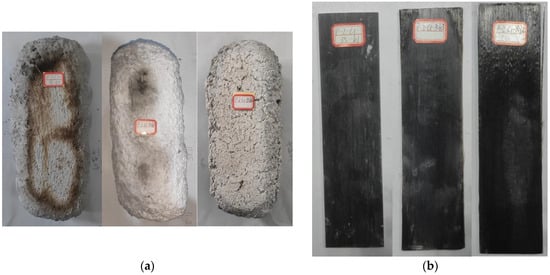
Figure 9.
CFRP sheets exposed after 0.5 h, 0.75 h, and 1 h standard fire: (a) before the removal of coatings; (b) after the removal of coatings.

Figure 10.
Failure modes of CFRP specimens are: (a) after 0.5 h standard fire; (b) after 0.75 h standard fire; and (c) after 1 h standard fire.
Figure 11 displays the load–deflection curves of CFRP specimens with different thicknesses after exposure to the standard fire. These load–deflection curves also demonstrated linear elastic properties. Upon reaching a specific load level, the specimen experienced sudden failure and brittle damage. Notably, the peak loads of CFRP sheets after 1 h of heating showed a significant reduction compared to those after 0.5 h and 0.75 h of heating.
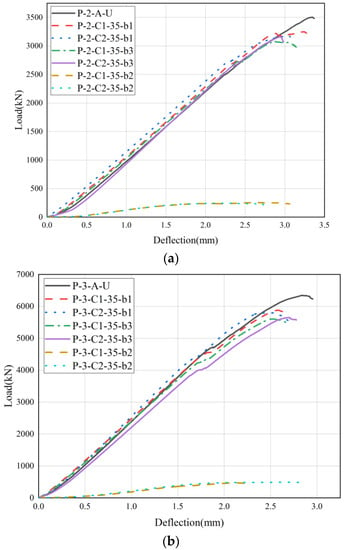
Figure 11.
Load–deflection curves of CFRP sheets with various thicknesses after standard fire exposure: (a) 2 mm thickness; (b) 3 mm thickness.
The flexural properties of CFRP specimens after exposure to standard fire are shown in Table 4. The thickness of the fireproof coatings under standard fire conditions amounted to 35 mm, which played a dominant role in influencing the fire protection effectiveness of the coatings. Conversely, variations in coating types and sheet thicknesses exhibited minimal impact on the post-fire flexural performance. The reduction factors of flexural strength and flexural modulus of CFRP sheets coated with coatings of 35 mm, heated for 0.5 h and 0.75 h, were approximately 0.90, indicating that the fireproof coatings provide effective fire protection to the CFRP sheets during these periods. However, after 1 h heating, the flexural strength and modulus for CFRP sheets with coatings of 35 mm thickness exhibited a significant decrease to only 0.07 and 0.13 times those at ambient temperature, implying the reduced effectiveness of coatings in protecting CFRP sheets after relatively long exposure to elevated temperatures (i.e., beyond 900 °C under the standard fire condition), leading to significant degradation in the performance of CFRP composites. This failure can be related to the high-temperature resistance of the coating and the effectiveness of the fire barrier. The fracture deflection remains almost unchanged under standard fire conditions. Consequently, it can be concluded that CFRP sheets coated with Type C1 and C2 coatings of 35 mm thickness demonstrate a fire-resistance duration exceeding 0.75 h under standard fire conditions.

Table 4.
Bending test results of CFRP sheets after exposure to the standard fire.
According to the Chinese specification GB50016-2014 [38], under the standard fire condition, CFRP sheets coated with Type C1 and C2 coatings of 35 mm thickness meet the requirements of fire-resistance class IV (columns), class IV (beams), and class III (floor slabs), respectively.
3.3. Comparison with Previous Studies
In the study conducted by Zhuge et al. [41], they conducted fire resistance tests to investigate the effect of two different fire-retardant materials, high-silica needled felt and ceramic fiber felt, on the fire resistance of CFRP tendons. Their criteria for evaluating fire resistance were based on a reduction in tensile strength and elastic modulus to 80% of their initial properties at 300 °C. In another study conducted by Khaneghahi et al. [30], the results revealed that the flexural modulus retention of the composite was stable, staying above 90% of the initial performance after cooling from temperatures below 300–350 °C. Once exceeding the temperature of degradation, there was a rapid loss of flexural modulus retention. Therefore, it can be assumed that the CFRP composites have reached their fire resistance at a temperature of 300 °C. Comparative information with other fireproof measures is displayed in Table 5.

Table 5.
Comparison with previous studies.
These results underscore that the novel fireproof coatings in this paper have certain advantages. The newly developed fireproof coatings offer better fire protection compared to other coatings. In addition, high-silica needled felt and ceramic fiber felt are not applicable in practical structural engineering, though their fire resistance durations are longer.
4. Conclusions
This paper investigates the effect of two self-developed fireproof coatings on the fire resistance of CFRP composite sheets, focusing on the effects on post-fire flexural properties. Based on the findings of this study, the following conclusions can be summarized:
- After fire exposure, the post-fire flexural properties of uncoated CFRP sheets experience a significant reduction.
- The proposed fireproof coatings significantly enhance the post-fire flexural strength and modulus of CFRP sheets up to a maximum achievable enhancement level of approximately 95% of the initial performance before fire exposure, with the coating thickness, type, and CFRP sheet thickness influencing the enhancement effect.
- CFRP sheets coated with Type C1 and C2 coatings of more than 25 mm thickness demonstrate a fire-resistance duration of up to 2 h under the large-space fire condition. According to the Chinese specification GB50016-2014, under the large-space fire condition, CFRP sheets coated with Type C1 and C2 coatings of over 25 mm thickness meet the requirements of fire-resistance class III (columns), class I (beams), and class I (floor slabs), respectively.
- CFRP sheets coated with Type C1 and C2 coatings of 35 mm thickness demonstrate a fire-resistance duration of up to 0.75 h under standard fire conditions. According to the Chinese specification GB50016-2014, under the standard fire condition, CFRP sheets coated with Type C1 and C2 coatings of 35 mm thickness meet the requirements of fire resistance class IV (columns), class IV (beams), and class III (floor slabs), respectively.
- Additional experimental studies are required to comprehensively assess the impact of these coatings on the mechanical performance of CFRP composites across a broader spectrum of fire conditions, providing guidance for the safe fire protection design of CFRP in new infrastructure and structural reinforcement applications.
Author Contributions
Conceptualization, X.Q. and X.J.; methodology, X.Q. and X.J.; software, K.W.; investigation, K.W. and Y.X.; data curation, X.Q.; writing—original draft preparation, K.W. and Y.E.; writing—review and editing, X.Q. and X.J.; visualization, K.W.; supervision, X.J.; project administration, X.Q. and X.J.; funding acquisition, X.Q. and Y.X. All authors have read and agreed to the published version of the manuscript.
Funding
This research was funded by the Natural Science Foundation of China (52278207, 52278206), the National Key R&D Program of China (2020YFD1100403), the China State Construction Technology R&D Program (CSCEC-2020-Z-1), the Chongqing Natural Science Foundation (CSTB2022NSCQ-MSX1219), and the Fundamental Research Funds for the Central Universities.
Institutional Review Board Statement
Not applicable.
Informed Consent Statement
Not applicable.
Data Availability Statement
Data are not publicly available due to privacy or ethical restrictions.
Conflicts of Interest
The authors declare no conflict of interest.
References
- Qiang, X.; Chen, L.; Jiang, X. Experimental and Theoretical Study on Flexural Behavior of Steel–Concrete Composite Beams Strengthened by CFRP Plates with Unbonded Retrofit Systems. Compos. Struct. 2023, 309, 116763. [Google Scholar] [CrossRef]
- Nigro, E.; Cefarelli, G.; Bilotta, A.; Manfredi, G.; Cosenza, E. Fire Resistance of Concrete Slabs Reinforced with FRP Bars. Part I: Experimental Investigations on the Mechanical Behavior. Compos. Part B Eng. 2011, 42, 1739–1750. [Google Scholar] [CrossRef]
- Kandare, E.; Kandola, B.K.; Myler, P.; Edwards, G. Thermo-Mechanical Responses of Fiber-Reinforced Epoxy Composites Exposed to High Temperature Environments. Part I: Experimental Data Acquisition. J. Compos. Mater. 2010, 44, 3093–3114. [Google Scholar] [CrossRef]
- Bisby, L.A.; Green, M.F.; Kodur, V.K.R. Response to Fire of Concrete Structures That Incorporate FRP. Prog. Struct. Eng. Mater. 2005, 7, 136–149. [Google Scholar] [CrossRef]
- Hamad, R.J.A.; Megat Johari, M.A.; Haddad, R.H. Mechanical Properties and Bond Characteristics of Different Fiber Reinforced Polymer Rebars at Elevated Temperatures. Constr. Build. Mater. 2017, 142, 521–535. [Google Scholar] [CrossRef]
- Naguib, H.M.; Zhang, X.H. Advanced Recycled Polyester Based on PET and Oleic Acid. Polym. Test. 2018, 69, 450–455. [Google Scholar] [CrossRef]
- Zhao, X.; Zhang, L. State-of-the-Art Review on FRP Strengthened Steel Structures. Eng. Struct. 2007, 29, 1808–1823. [Google Scholar] [CrossRef]
- Bazli, M.; Abolfazli, M. Mechanical Properties of Fibre Reinforced Polymers under Elevated Temperatures: An Overview. Polymers 2020, 12, 2600. [Google Scholar] [CrossRef] [PubMed]
- Haroon, M.; Moon, J.S.; Kim, C. Performance of Reinforced Concrete Beams Strengthened with Carbon Fiber Reinforced Polymer Strips. Materials 2021, 14, 5866. [Google Scholar] [CrossRef]
- Alhassan, M.; Al-Rousan, R.; Ababneh, A. Flexural Behavior of Lightweight Concrete Beams Encompassing Various Dosages of Macro Synthetic Fibers and Steel Ratios. Case Stud. Constr. Mater. 2017, 7, 280–293. [Google Scholar] [CrossRef]
- Al-Rousan, R. Influence of Polypropylene Fibers on the Flexural Behavior of Reinforced Concrete Slabs with Different Opening Shapes and Sizes. Struct. Concr. 2017, 18, 986–999. [Google Scholar] [CrossRef]
- Ababneh, A.; Al-Rousan, R.; Alhassan, M.; Alqadami, M. Influence of Synthetic Fibers on the Shear Behavior of Lightweight Concrete Beams. Adv. Struct. Eng. 2017, 20, 1671–1683. [Google Scholar] [CrossRef]
- Qiang, X.; Bijlaard, F.S.K.; Kolstein, H. Post-Fire Mechanical Properties of High Strength Structural Steels S460 and S690. Eng. Struct. 2012, 35, 1–10. [Google Scholar] [CrossRef]
- Qiang, X.; Bijlaard, F.S.K.; Kolstein, H. Post-Fire Performance of Very High Strength Steel S960. J. Constr. Steel Res. 2013, 80, 235–242. [Google Scholar] [CrossRef]
- Qiang, X.; Jiang, X.; Bijlaard, F.S.K.; Kolstein, H.; Luo, Y. Post-Fire Behaviour of High Strength Steel Endplate Connections—Part 2: Numerical Study. J. Constr. Steel Res. 2015, 108, 94–102. [Google Scholar] [CrossRef]
- Rosa, I.; Firmo, J.; Correia, J.; Mazzuca, P. Influence of Elevated Temperatures on the Bond Behaviour of GFRP Bars to Concrete—Pull-out Tests. In Proceedings of the IABSE Symposium 2019 Guimaraes: Towards a Resilient Built Environment-Risk and Asset Management, Guimaraes, Portugal, 27–29 March 2019; IABSE C/O ETH Zurich: Zurich, Switzerland, 2019; pp. 861–868. [Google Scholar] [CrossRef]
- Wang, K.; Young, B.; Smith, S.T. Mechanical Properties of Pultruded Carbon Fibre-Reinforced Polymer (CFRP) Plates at Elevated Temperatures. Eng. Struct. 2011, 33, 2154–2161. [Google Scholar] [CrossRef]
- Wong, P.M.H.; Davies, J.M.; Wang, Y.C. An Experimental and Numerical Study of the Behaviour of Glass Fibre Reinforced Plastics (GRP) Short Columns at Elevated Temperatures. Compos. Struct. 2004, 63, 33–43. [Google Scholar] [CrossRef]
- Jarrah, M.; Najafabadi, E.P.; Khaneghahi, M.H.; Oskouei, A.V. The Effect of Elevated Temperatures on the Tensile Performance of GFRP and CFRP Sheets. Constr. Build. Mater. 2018, 190, 38–52. [Google Scholar] [CrossRef]
- Hajiloo, H.; Green, M.F.; Gales, J. Mechanical Properties of GFRP Reinforcing Bars at High Temperatures. Constr. Build. Mater. 2018, 162, 142–154. [Google Scholar] [CrossRef]
- Robert, M.; Benmokrane, B. Behavior of GFRP Reinforcing Bars Subjected to Extreme Temperatures. J. Compos. Constr. 2010, 14, 353–360. [Google Scholar] [CrossRef]
- Kodur, V.K.R.; Bisby, L.A.; Foo, S.H.C. Thermal Behavior of Fire-Exposed Concrete Slabs Reinforced with Fiber-Reinforced Polymer Bars. ACI Struct. J. 2005, 102, 799–807. [Google Scholar] [CrossRef]
- Bai, Y.; Vallée, T.; Keller, T. Modeling of Thermal Responses for FRP Composites under Elevated and High Temperatures. Compos. Sci. Technol. 2008, 68, 47–56. [Google Scholar] [CrossRef]
- Wang, Y.C.; Wong, P.M.H.; Kodur, V. An Experimental Study of the Mechanical Properties of Fibre Reinforced Polymer (FRP) and Steel Reinforcing Bars at Elevated Temperatures. Compos. Struct. 2007, 80, 131–140. [Google Scholar] [CrossRef]
- Yu, B.; Kodur, V. Effect of Temperature on Strength and Stiffness Properties of Near-Surface Mounted FRP Reinforcement. Compos. Part B Eng. 2014, 58, 510–517. [Google Scholar] [CrossRef]
- Katsoulis, C.; Kandola, B.K.; Myler, P.; Kandare, E. Post-Fire Flexural Performance of Epoxy-Nanocomposite Matrix Glass Fibre Composites Containing Conventional Flame Retardants. Compos. Part A Appl. Sci. Manuf. 2012, 43, 1389–1399. [Google Scholar] [CrossRef]
- Ashrafi, H.; Bazli, M.; Najafabadi, E.P.; Vatani Oskouei, A. The Effect of Mechanical and Thermal Properties of FRP Bars on Their Tensile Performance under Elevated Temperatures. Constr. Build. Mater. 2017, 157, 1001–1010. [Google Scholar] [CrossRef]
- Wang, Y.C.; Kodur, V. Variation of Strength and Stiffness of Fibre Reinforced Polymer Reinforcing Bars with Temperature. Cem. Concr. Compos. 2005, 27, 864–874. [Google Scholar] [CrossRef]
- Xu, J.; Wang, W.; Han, Q. Mechanical Properties of Pultruded High-Temperature-Resistant Carbon-Fiber-Reinforced Polymer Tendons at Elevated Temperatures. Constr. Build. Mater. 2020, 258, 119526. [Google Scholar] [CrossRef]
- Khaneghahi, M.H.; Najafabadi, E.P.; Shoaei, P.; Oskouei, A.V. Effect of Intumescent Paint Coating on Mechanical Properties of FRP Bars at Elevated Temperature. Polym. Test. 2018, 71, 72–86. [Google Scholar] [CrossRef]
- Shekarchi, M.; Farahani, E.M.; Yekrangnia, M.; Ozbakkaloglu, T. Mechanical Strength of CFRP and GFRP Composites Filled with APP Fire Retardant Powder Exposed to Elevated Temperature. Fire Saf. J. 2020, 115, 103178. [Google Scholar] [CrossRef]
- Naguib, H.M. Environmental-Friendly Recycled Polyester/Mg(OH)2 Nanocomposite: Fire-Retardancy and Thermal Stability. Polym. Test. 2018, 72, 308–314. [Google Scholar] [CrossRef]
- Rallini, M.; Natali, M.; Kenny, J.M.; Torre, L. Effect of Boron Carbide Nanoparticles on the Fire Reaction and Fire Resistance of Carbon Fiber/Epoxy Composites. Polymer 2013, 54, 5154–5165. [Google Scholar] [CrossRef]
- ACI 440.2R-17; Guide for the Design and Construction of Externally Bonded FRP Systems for Strengthening Concrete Structures, ACI Committee 440. American Concrete Institute (ACI): Farmington Hills, MI, USA, 2017.
- ISO 834-1; Fire-Resistance Tests—Elements of Building Construction—Part 1: General Requirements. ISO: Geneva, Switzerland, 2021.
- CECS 200-2006; Technical Code for Fire Safety of Steel Structure in Buildings. China Association for Engineering Construction Standardization (CECS): Beijing, China, 2006.
- GB 14907-2018; Fire Resistive Coating for Steel Structure. Standardization Administration of China: Beijing, China, 2018.
- GB 50016-2014; Code for Fire Protection Design of Buildings. AQSIQ: Beijing, China, 2018.
- ASTM D790; Standard Test Methods for Flexural Properties of Unreinforced and Reinforced Plastics and Electrical Insulating Materials. ASTM International: West Conshohocken, PA, USA, 2017.
- BS 5950-8-2003; Structural Use of Steelwork in Building—Part 8: Code of Practice for Fire Resistant Design. BSI: London, UK, 2003.
- Zhuge, P.; Tao, G.; Wang, B.; Jie, Z.; Zhang, Z. Effects of High Temperatures on the Performance of Carbon Fiber Reinforced Polymer (CFRP) Composite Cables Protected with Fire-Retardant Materials. Materials 2022, 15, 4696. [Google Scholar] [CrossRef]
Disclaimer/Publisher’s Note: The statements, opinions and data contained in all publications are solely those of the individual author(s) and contributor(s) and not of MDPI and/or the editor(s). MDPI and/or the editor(s) disclaim responsibility for any injury to people or property resulting from any ideas, methods, instructions or products referred to in the content. |
© 2023 by the authors. Licensee MDPI, Basel, Switzerland. This article is an open access article distributed under the terms and conditions of the Creative Commons Attribution (CC BY) license (https://creativecommons.org/licenses/by/4.0/).